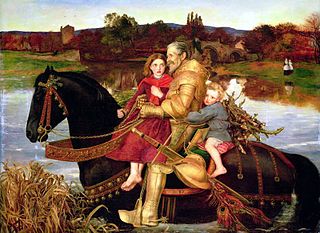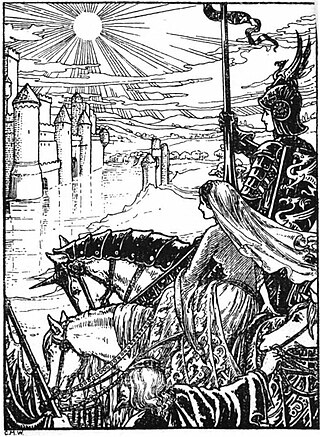Related Research Articles

Uther Pendragon (Brittonic), also known as King Uther, was a legendary King of the Britons and father of King Arthur.

Sir Orfeo is an anonymous Middle English Breton lai dating from the late 13th or early 14th century. It retells the story of Orpheus as a king who rescues his wife from the fairy king. The folk song Orfeo is based on this poem.
Floris and Blancheflour is the name of a popular romantic story that was told in the Middle Ages in many different vernacular languages and versions. It first appears in Europe around 1160 in "aristocratic" French. Roughly between the period 1200 and 1350 it was one of the most popular of all the romantic plots.

As a literary genre, the chivalric romance is a type of prose and verse narrative that was popular in the noble courts of high medieval and early modern Europe. They were fantastic stories about marvel-filled adventures, often of a chivalric knight-errant portrayed as having heroic qualities, who goes on a quest. It developed further from the epics as time went on; in particular, "the emphasis on love and courtly manners distinguishes it from the chanson de geste and other kinds of epic, in which masculine military heroism predominates."

The story of the Knight of the Swan, or Swan Knight, is a medieval tale about a mysterious rescuer who comes in a swan-drawn boat to defend a damsel, his only condition being that he must never be asked his name.
Apollonius of Tyre is the hero of a short ancient novel, popular in the Middle Ages. Existing in numerous forms in many languages, all are thought to derive from an ancient Greek version now lost.

Sir Isumbras is a medieval metrical romance written in Middle English and found in no fewer than nine manuscripts dating to the fifteenth century. This popular romance must have been circulating in England before 1320, because William of Nassyngton, in his work Speculum Vitae, which dates from this time, mentions feats of arms and other 'vanities', such as those found in stories of Sir Guy of Warwick, Bevis of Hampton, Octavian and Sir Isumbras. Unlike the other three stories, the Middle English Sir Isumbras is not a translation of an Old French original.

Libeaus Desconus is a 14th-century Middle English version of the popular "Fair Unknown" story, running to about around 2,200 lines, attributed to Thomas Chestre. It is a version or an adaptation of Renaut de Beaujeu's Le Bel Inconnu though comparatively much shorter.
"Le Fresne" is one of the Lais of Marie de France. It was likely written in the late 12th century. Marie claims it to be a Breton lai, an example of Anglo-Norman literature.

Grateful dead is both a motif and a group of related folktales present in many cultures throughout the world.
Emaré is a Middle English Breton lai, a form of mediaeval romance poem, told in 1035 lines. The author of Emaré is unknown and it exists in only one manuscript, Cotton Caligula A. ii, which contains ten metrical narratives. Emaré seems to date from the late fourteenth century, possibly written in the North East Midlands. The iambic pattern is rather rough.
The Squire of Low Degree, also known as The Squyr of Lowe Degre, The Sqyr of Lowe Degre or The Sqyr of Lowe Degree, is an anonymous late Middle English or early Modern English verse romance. There is little doubt that it was intended to be enjoyed by the masses rather than the wealthy or aristocratic sections of society, and, perhaps in consequence of this, it was one of the better-known of the English romances during the Elizabethan and Jacobean eras, and again in the 19th century. There are three texts of the poem: it was printed by Wynkyn de Worde c. 1520 under the title Undo Youre Dore, though only fragments totalling 180 lines survive of this book; around 1555 or 1560 another edition in 1132 lines was produced by William Copland; and a much shorter version, thought to have been orally transmitted, was copied into Bishop Percy's Folio Manuscript around the middle of the 17th century. The precise date of the poem is unknown, estimates varying from 1440 to 1520, but Henry Bradley's date of c. 1475 has been quite widely adopted. Standing as it does at the very end of the English Middle Ages it has been called "a swan song of the romance".

Sir Gowther is a relatively short Middle English tail-rhyme romance in twelve-line stanzas, found in two manuscripts, each dating to the mid- or late-fifteenth century. The poem tells a story that has been variously defined as a secular hagiography, a Breton lai and a romance, and perhaps "complies to a variety of possibilities." An adaptation of the story of Robert the Devil, the story follows the fortunes of Sir Gowther from birth to death, from his childhood as the son of a fiend, his wicked early life, through contrition and a penance imposed by the Pope involving him in a lowly and humiliating position in society, and to his eventual rise, via divine miracles, as a martial hero and ultimately to virtual canonization. But despite this saintly end, "like many other lays and romances, Sir Gowther derives much of its inspiration from a rich and vastly underappreciated folk tradition."
Generides or Generydes is an English verse romance, originating in the English Midlands and dated to the end of the 14th century. It survives in two different lengthy forms. The hero Generides is born as an illegitimate son of the King of India, and after adventures marries a princess of Persia and becomes ruler of both India and Persia.
Le Bone Florence of Rome is a medieval English chivalric romance. Featuring the innocent persecuted heroine, it is subcategorized into the Crescentia cycle of romances because of two common traits: the heroine is accused by her brother-in-law after an attempted seduction, and the story ends with her fame as a healer bringing all her persecutors to her.
The Erl of Toulouse is a Middle English chivalric romance centered on an innocent persecuted wife. It claims to be a translation of a French lai, but the original lai is lost. It is thought to date from the late 14th century, and survives in four manuscripts of the 15th and 16th centuries. The Erl of Toulouse is written in a north-east Midlands dialect of Middle English.
Amadas, or Sir Amadace is a medieval English chivalric romance, one of the rare ones for which there is neither a known nor a conjectured French original, like Sir Eglamour of Artois. The hero shares a name but no more with the romance Amadas et Idoine.
Roswall and Lillian is a medieval Scottish chivalric romance. A late appearing tale, it nevertheless draws heavily on folkloric motifs for its account of an exiled prince, reduced to poverty, who rises from it to win a princess.
Crescentia is an Early Middle High German language chivalric romance, included in the Kaiserchronik about 1150. Other versions appeared in the thirteenth and fourteenth centuries, in prose and verse.

Athelston is an anonymous Middle English verse romance in 812 lines, dating from the mid or late 14th century. Modern scholars often classify it as a "Matter of England" romance, because it deals entirely with pre-Conquest English settings and characters. It is mainly written in twelve-line stanzas rhyming AABCCBDDBEEB, though the poet occasionally varies his meter with stanzas of eight, six, or four lines. The poem survives in only one manuscript, the early 15th-century Gonville and Caius MS 175, which also includes the romances Richard Coer de Lyon, Sir Isumbras and Beves of Hamtoun. It has no title there. Athelston was first printed in 1829, when C. H. Hartshorne included it in his Ancient Metrical Tales.
References
- 1 2 3 Laura A. Hibbard, Medieval Romance in England p79 New York Burt Franklin,1963
- 1 2 Head, Dominic (2006). The Cambridge Guide to Literature in English (preview) (3rd ed.). Cambridge University Press. ISBN 0-521-83179-2.
- 1 2 3 French & Hale 1930 , pp. 875-
- ↑ "THE WICKED AGE: MIDDLE ENGLISH COMPLAINT LITERATURE IN TRANSLATION"
- 1 2 3 "Sir Cleges: Introduction", Edited by Anne Laskaya and Eve Salisbury
- ↑ Laura A. Hibbard, Medieval Romance in England p80 New York Burt Franklin,1963